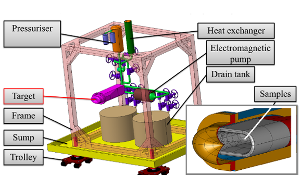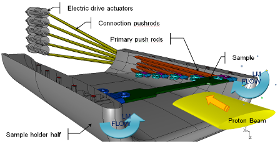![]() Irradiation facility for target testing
Irradiation facility for target testing


Fig 1 left: Compact irradiation device developed at CERN within TIARA WP9. Image credits: TIARA/CERN.
Fig 2 right: Sample holder (one half) with sample loading mechanism. Image credits: TIARA/CERN.
In TIARA Work Package 9, the team led by scientists and engineers from CERN are developing a compact irradiation device. This installation is a key infrastructure for the accomplishment of the R&D programme that is required to enable the construction of EURISOL, the next generation facility for the production of very intense radioactive ion beams (RIB), and also for other projects such as the European Spallation Source (ESS) or the development of Accelerator Driven Systems with the MYRRHA project.
The compact irradiation device is shown in Fig. 1. The target shown in the detail can absorb a 100 kW proton beam and, through spallation of a dense liquid metal flowing inside, releases a high-density hard neutron flux in a volume which can accommodate various experimental devices. One such device is shown in Fig. 2 and illustrates how tensile specimens may be remotely stress-tested using a robust mechanical system, whilst being bombarded by the proton beam and the neutrons released by the spallation of dense liquid metal flowing around the samples.
Evidently the setup can be used to test medical applications, nuclear instrumentation or any other type of device for which a high density neutron field is required. The entire apparatus is housed within a cube 1.5m on a side, for easy transport. Disassembly and treatment of the waste is facilitated by the development of a compact heat exchanger which mechanically separates the primary from the secondary loop.
